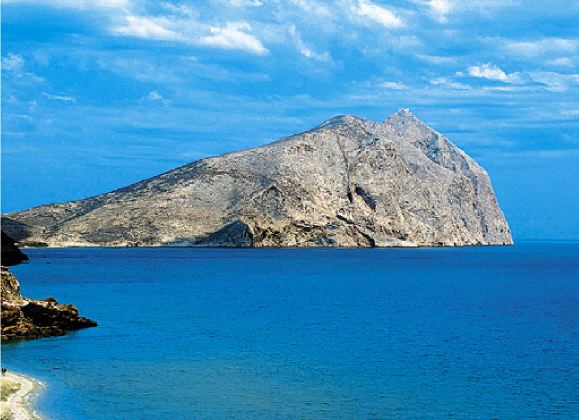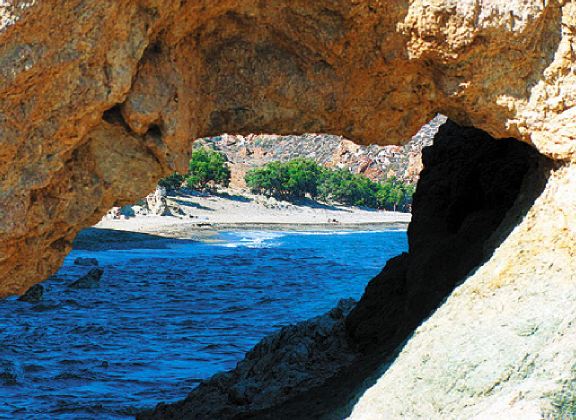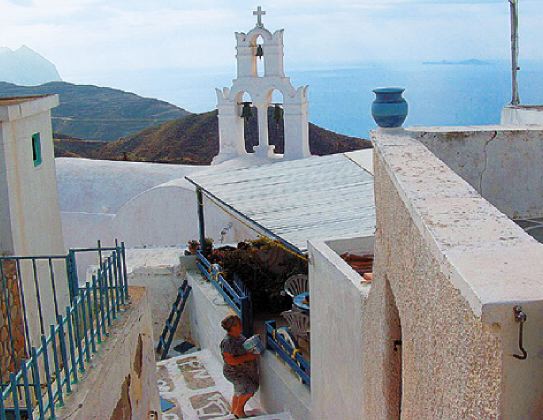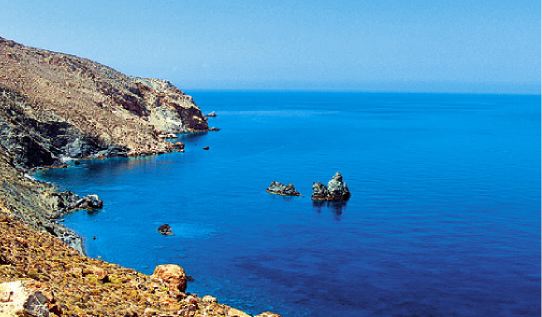 |
||
|
Putting Anafi into Perspective
|
||
|
This remote Cycladic island is dominated by one big rock, a string of sandy beaches, a traditional Hora and some memorable illusions JETHRO Tull bought me dinner, there's a bad moon rising and Mt Kalamos is the biggest mountain in the Mediterranean. In the monastery on the top you will find a mad monk serving alcohol and at the bottom is a 2,500-year-old chicken run. The islets of Ftena, Pahia and Makria have started to move around and change size and shape... It all depends on your perspective. The illusions start with Nick the illustrator, fellow-traveller on the splendidly spartan Nisos Thira, my undisputed ship of the year for its welcome and sense of style. A ship, too, that is not all it seems to |
 Mount Kalamos at 584m (or 450?) is said to be the highest single rock formation in the Mediterranean |
|
|
be. Because it used to be the Nisos Kythira before someone none too expertly rubbed out a couple of letters and it moved away from the Peloponnese to become the champion provider for the smaller southern Cyclades. Nick is talking about the importance of cheating, about drawing lines in the mind and not with the hand, of putting things where you want them to be rather than where they actually are. "Then you will remember them like that." And while I am learning about these tricks, Jethro Tull are basking in the sun, shirts off, their guitars stacked up in the shade. And all the while, Anafi is drawing closer. Or perhaps that should be appearing more quickly. It all depends on... |
||
Partly, yes, Nick agrees. But imagine your field of vision is a page, and see where the rock lies? In the second third of the page. That is where the main subject will always be because that is where your eye is drawn. He's right about the location of Kalamos on the imaginary page, but it all feels a bit fishy. Kalamos is also the biggest mountain in the Mediterranean, I say, and maybe that's got something to do with it. Later, I check up, and have to correct myself. It is not the highest mountain, it is said to be the highest single rock formation in the Mediterranean, I tell him, at either 584m, or 450m, depending on which source you believe and that, I point out, is a big difference. But Nick is unimpressed with the precision of words or numbers. Maybe in percentage terms, he says, but not in terms of perspective. |
 The Monastery of Kalamiotissa sits atop Mt Kalamos
|
|
| Arrival at Agios Nikolaos, the island's only real port (and a tiny one at that), requires practical measures be taken. There is a mule track up the ravine that leads to the Cycladic Hora at the top but everyone opts for the bus instead. Five minutes later we are there. The town is of traditional whitewashed-stone and traffic-free steps and alleys but is unusual because of the way in which it follows the contour lines of a conical hill, so that to get anywhere you either have to traverse or climb. Places to get to can be counted on your fingers. A few tavernas, a bakery, two mini-markets, a fruit store and a tiny souvenir shop which (like the bakery) posts the island's boat schedules...in Greek only. There is no bank or ATM. If a shop is closed and you want it to open, wait outside, someone will notice and before long the owner will arrive to open up. It's that kind of place. There are about 200 permanent residents. |
||
Thanks to the town's design and location it is not hard to find a room with a sunset view over the Aegean and Anafi's three little islets - Ftena, Pahia and Makria. And travellers from the Nisos Thira end up on roughly the same contour lines, which means they keep bumping into each other. It seems to me that Ftena should really be Ftera (φτερά) because it looks as though it has a pair of wings. "Here and now it does," says Nick, who is in the middle of giving Jethro Tull's lead singer and flautist Ian Anderson a drawing lesson on his verandah, "but that can all change. Anyway, it depends if you want it to have wings." |
 A view of Megalos Roukounas beach from Mikros Roukounas beach |
|
| Nick and his girlfriend Barbara have decided they must be from Jethro Tull. They look the right age and we know Jethro Tull's Anderson, like our grey-pigtailed Anderson, is from Scotland. We think the shorter man might be guitarist Martin Barre, even though that isn't exactly a Scottish name and nobody is sure if it's the right name anyway. Overall, our combined knowledge of Jethro Tull is pretty skimpy. But the fact that Barre plays for a band has already been teased out of him, as well as the little nugget that he always takes his guitar with him in case he feels inspired to write a song. And by the way, they did not bring the guitars to perform... Yes, of course, they must be sick of being asked to do that when they're on holiday. But where is Anderson's famous flute, and why has he never yet exercised standing on one leg? Ask them, I suggest to Barbara, when they were last at the Irodion in Athens. I remember Jethro Tull played there a couple of years ago. Nick tells Anderson his drawing has promise. And then, taking a plain sheet of paper, he shows him how he should really do it. When you draw a straight line, he explains, don't look at it, look just above it and your mind will draw it straight for you. Cut out all that sea, put the islets where you want them, give them a shape that works and now put something big in the foreground for perspective. The sketch, in a matter of minutes and with the lightest of touches, has grown into something we all instantly recognise. He doesn't give Ftena wings. That night, a giant red moon comes up over the sea. I catch Anderson's eye across To Steki taverna where we all seem to have ended up at different tables. "Bad moon rising..." he quotes. Is that from Aqualung? I wonder. "Creedence Clearwater Revival, " he shouts across, before I have time to ask. Or, looked at another way, it could be Mercury crossing the sun. Heading east Outside the Hora, there is only one way you can really go which is, of course, east. Mt Kalamos beckons. There is a new road, but much better is to walk along a footpath that skirts the coast and ducks in and out of fields that represent Anafi's only cultivated land. On the way, you pass or drop down to maybe seven or eight sandy beaches, a couple with tavernas and a few with tamarisk trees. All deserted and picturesque. After about 4km, half-way along, you reach what was the island's centre in Hellenistic times - Katelimatsa. |
||
| Earlier, while wandering round Hora, I had got lucky. I happened to pass a small room with its door open which turned out to house Anafi's archaeological collection. There was a brief history of the island pinned up on the wall (in Greek only). Unremarkably for the Cyclades, Anafi was under Venetian control in the 13th century and was frequently raided by pirates both before and while the Turks were in control in the years that followed. The rest of the room was stuffed full of antiquities and there were also pictures of Anafi coins dating back to 300BC, with Apollo on one side and a bee on the other. Strange! The sculptures and other objects, like jars for storing grain and oil, dated from Roman times (30BC to the 4th century AD), but there was also said to be evidence in situ of the island's occupation long before then. Hence Katelimatsa, for a start. At Katelimatsa there is the mound of what was presumably an ancient acropolis as well as the beginnings of the Sacred Way which once led to the |
 A Hora street scene |
|
| Temple of Apollo. And on a hilltop up above at Kastelli, the Roman finds were made that are kept in that little room in Hora. It was a substantial settlement, but today there are just parts of walls remaining and some other artefacts left in place, like, for example, a precisely-detailed marble sarcophagus outside the cemetery. But the Romans don't fully define Kastelli. As always on Anafi, there is another dimension. The Dorians were the first people to build here, in the 8th century BC. It is at the 2,500-year-old Temple of Apollo, at the base of Mt Kalamos, where the ancient world has left its most significant and impressive remains. The temple has since been adopted by Christians and chickens. The Christians arrived at the end of the 16th century and erected their cupola (in this case of the monastery of Zoodohos Pigi) in the midst of the giant Apollonian stone walls that you can still see today. Just outside the monastery, but within an old precinct of the temple that still stands, is a busy chicken run. It is not clear when they first arrived. But this must surely be the most exclusive and idyllic chicken coop in the world. No wonder the cocks never stop crowing. Behind the site, a path weaves up the giant slab of rock that is Mt Kalamos. At the top, invisible on the way up, is another monastery called Kalamiotissa. In the early stages of the climb, you sometimes have to look ahead and not at your feet, drawing the path in your mind like that straight line on paper in order to be able to follow it. The walk is exhilarating and punctuated every so often by a fiercesome whine. Ah! This explains the ancient coin. Originator of the sound is a bee, which approaches with a rapier-like forward antenna, and fortunately keeps pulling away at the last moment. |
||
The biggest rock in the Mediterranean? It is quite a thought. And the ascent is made a touch surreal by the prospect of meeting the mad monk who serves alcohol at the top. At least, that is the information that Jethro Tull's Anderson (who has, it turns out, been to Anafi before) passed onto Nick the illustrator. It seems an ever more absurd idea, the higher you get. A halo of wispy cloud swirls round the peak and on rounding the final bend the wrinkled surface of the Aegean is, abruptly, just a footstep away. The drop on this side is almost sheer. And in front, clipped right to the top of the rock in a gesture of both architectural daring and monastic exuberance, is Kalamiotissa. It is deserted and locked. No mad monk, no alcohol. Just the top of the world. So the idea was absurd. |
 A coastal walk scene |
|
| Or was it? Perhaps transmigration is another kind of perspective. Looking down, the three islets have changed place again - and size and shape. Ftena has even lost its wings, just the way Nick drew it. And it is only on the descent that it emerges the monk and the alcohol do exist, but that - today at least - they are at the bottom not the top, in one monastery rather than the other. Anafi on my mind On the last night, we all sit at the same table in To Steki. A camaraderie has developed between the travellers who arrived on the Nisos Thira. Anafi, because it feels remote, because the pace of life is slow, because there are so few visitors out of high season, promotes a sense of shared adventure. There is not much more to see on the island than this - the Hora, the fertile valleys and sandy beaches of the eastern flank, and Mt Kalamos. But Anafi, from the beginning, has always been more than you can see. Jason started it when he saw an island where there was none before. Nick taught us how to put things where we wanted them rather than where they were. And that is how we would then remember them. When were you last at the Irodion in Athens? I ask Anderson and Barre. What? They've never heard of the Irodion. But it doesn't matter any more. Because before we part that night, Barre discloses that he has been inspired to write a song about Anafi, and that Nick and I feature in it. And that's good enough for me. My story is that it was Jethro Tull who bought me dinner that night on Anafi. It's only a matter of perspective. How to get there The basic connection is with Santorini (a 90-minute trip), either on the Nisos Thira or one of the bigger ferries that sometimes call in. Check on www.openseas.gr Photos by Jonathan Carr |
||
|
|
||
(Posting Date 25 June 2007) HCS readers can view other excellent articles by this writer in the News & Issues and other sections of our extensive, permanent archives at the URL http://www.helleniccomserve.com./contents.html
All articles of Athens News appearing on HCS have been reprinted with permission. |
||
|
||
|
2000 © Hellenic Communication Service, L.L.C. All Rights Reserved. http://www.HellenicComServe.com |
||

